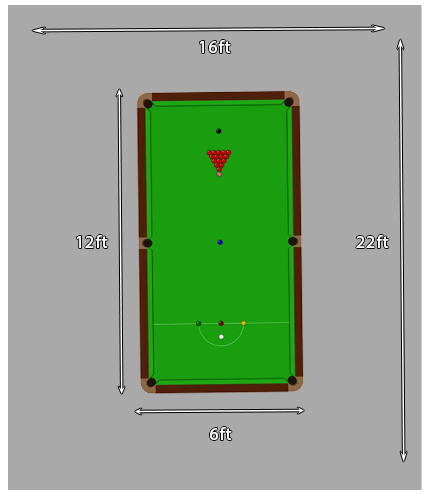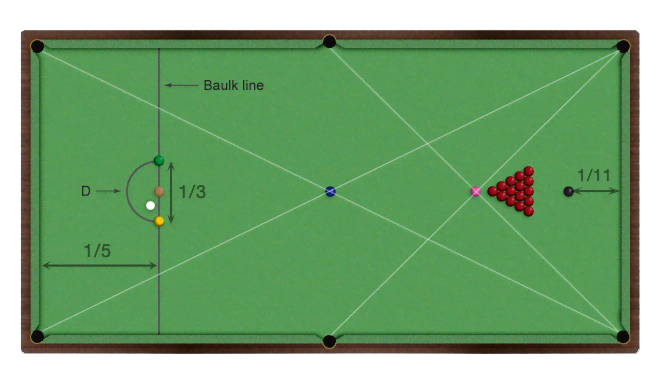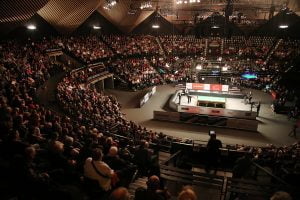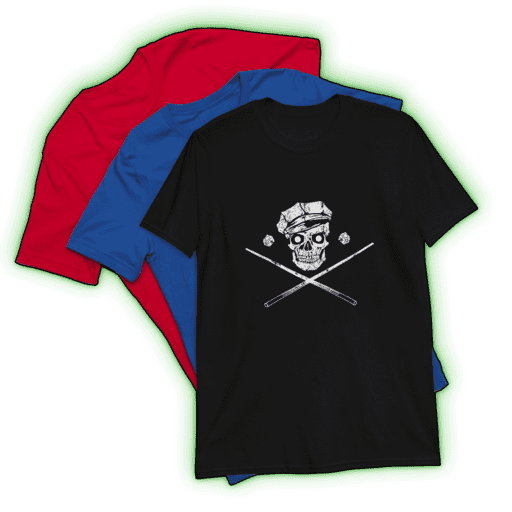If you’re looking to purchase a snooker table for your home or business, it can be overwhelming to choose the right one. With so many different sizes, materials, and qualities available, it’s essential to do your research to ensure you make an informed decision. In this buyer’s guide, we’ll take you through the key factors to consider when choosing a snooker table.
Overview
For snooker freaks, owning a snooker table is a dream. While it may not be essential for everyone, it’s worth considering if you really enjoy playing the game and have the available space and budget.
Traditionally, snooker tables were only limited to dedicated snooker clubs and sports centers. But today, they are becoming increasingly popular in private homes.
From full-size tournament-spec tables to small, folding MDF tables, there is a snooker table available to suit everyone’s needs.
Benefits of Having a Snooker Table at Home
Here are some possibilities that owning a snooker table at home can bring:
- Ability to play at any time at your own pace and on your own schedule.
- Opportunity to improve skills and get more practice.
- Potential for cost savings by eliminating club membership and public table fees.
- Option to customize and personalize your table to your liking.
- Social activity with friends and family to enjoy.
- Long-term investment that can provide entertainment for many years with proper care.
Investing in a snooker table for your home can offer long-term cost savings, as well as the added convenience and enjoyment of being able to play whenever you want.
Snooker Table Sizes
The first thing to consider when choosing a snooker table is its size. Snooker tables come in tfour common sizes.
Full-Size
Full-size snooker tables are the most common type of snooker tables. They are the standard size for professional tournaments and are commonly found in snooker clubs and professional venues.
Full-size snooker tables measure 12ft x 6ft with 8 legs support and require a minimum room size of 22ft x 16ft.
Billiard-Size
Billiard size snooker tables are slightly smaller than full-size tables, measuring 10ft x 5ft with 6 or 8 legs support. They are commonly found in pubs, bars, and other recreational establishments.
Billiard-size snooker tables are an excellent option for those who want to enjoy the game of snooker but don’t have space for a full-size table. They require a minimum room size of 20ft x 15ft.
Three-Quarter
3/4 size snooker tables are even smaller, measuring 9 ft x 4.5 ft with 4 or 6 legs to support.
Three-quarter size snooker table are a good option for those with limited space. They require a minimum room size of 19ft x 14ft.
Half-Size
Half-size snooker tables are the smallest type of snooker tables and are ideal for children or those with very limited space. They measure 6 ft x 3 ft with 4 or 6 legs support and require a minimum room size of 15ft x 12ft.
Average height of a snooker table (from floor to cushion top) is 34 inches. Snooker tables are always twice as long as they are wide.
Snooker Table Dimensions Chart
| Table Size | Minimum Room Size | Recommended Cue Length |
|---|---|---|
| Full-Size 12ft x 6ft | 22ft x 16ft (6.7m x 4.8m) | 4ft 10″ (58″) |
| Billiard-Size 10ft x 5ft | 20ft x 15ft (6.1m x 4.5m) | 4ft 10″ (58″) |
| Three-Quarter Size 9ft x 4.5ft | 19ft x 14ft (5.7m x 4.2m) | 4ft 10″ (58″) |
| Half Size 6ft x 3ft | 15ft x 12ft (4.5m x 3.6m) | 4ft 6″ (54″) |
Snooker tables need around 5ft of free space around the table to allow players to easily move around and use a full-size 57/58 inch cue.
If your room is too small for the 12 x 6 table, there are a whole range of snooker tables that come in different sizes i.e. 10 x 5, 9 x 4.5, 8 x 4 and 6 x 3 and come in a variety of types, such as snooker dining tables and folding snooker tables.

The recommended dimensions provided above serve as the minimum ideal for comfortable cueing in all situations, with some flexibility. However, you can still get away if your room is slightly smaller.
Snooker Table Parts
Snooker tables are typically made of three main materials: wood, slate, and cloth. The frame and legs of the table are usually made of hardwood, such as oak or maple, which provide durability and stability.
The quality of the materials used in a snooker table can greatly affect the playing experience, so it’s important to invest in a high-quality table made of durable materials.
Bed
The bed of a snooker table is the playing surface upon which the balls roll. It’s typically made of slate, which is a dense and flat material that provides a consistent and stable surface. The thickness and quality of the slate can vary.
The slate bed is covered with a green baize cloth. The bed of a snooker table is often composed of three or more slabs of slate, which are joined together and the gaps are filled and filed to create a seamless playing surface.
Non-slate tables (marble, MDF etc) are cheaper, less accurate, tend to warp and don’t generally last as long.
It’s important to maintain the slate bed by keeping it level and free from damage, as any imperfections can affect the ball roll, baize and overall playing performance. A well-maintained and high-quality slate bed is essential for top-notch snooker play.
Cloth
The bed of a snooker table is covered with green cloth (baize). It’s made of a special type of wool and has a nap that runs in a specific direction, which affects the speed and accuracy of the ball roll.
The nap of a snooker table is typically oriented from baulk to top end and is ironed and brushed in that same direction.
The cloth on a snooker table is a vital component that directly affects the quality of the game. The thickness of the cloth determines table’s speed (lack of friction) and spin response. Thicker cloths last longer but are slower and less responsive.
The cloth must be stretched tightly and evenly across the table, with no wrinkles or creases, to ensure a consistent playing surface.
It’s important to note that:
- It’s crucial to choose a high-quality snooker cloth that’s designed for durability and performance, as well as one that matches the specific size and shape of your table.
- Over time, the cloth will become worn and may need to be replaced to maintain optimal playing conditions.
- A well-maintained snooker table cloth is essential for achieving top-notch playing performance and enhancing the overall snooker experience.
Cushions
The cushions on a snooker table are the padded rails that surround the playing surface. They’re typically made of vulcanized rubber and are designed to rebound the balls off the cushion and back onto the playing surface.
The quality of the cushions can have a significant impact on the playing performance and overall quality of the game. Cushions of good quality are covered with the same cloth as the playing area to ensure a consistent rebound.
Over time, the cushions may become worn and lose their elasticity, affecting the ball rebound and accuracy. It’s important to maintain the cushions by keeping them clean and free from damage, and to replace them when they start to show signs of wear.
Pockets
Snooker tables have six pockets with smoothly-curved pocket openings, four at corners and two at the centre of long cushions. They’re typically made of leather and come in various sizes and shapes depending on the table’s design.
The pocket openings are usually 3.5″ (86 mm); however, professional tournament tables may have slightly tighter pockets.
The pockets must be securely attached to the table and be able to hold the balls without allowing them to bounce out. Over time, the pockets may become stretched, worn or damaged, which can affect their ability to hold the balls correctly.
Markings
The markings on a snooker table are a critical aspect of the game as they help to define the playing area and the position of the balls. The cloth is marked with a series of lines and spots that indicate where the balls should be placed or re-spotted.
Markings on a snooker table:
- Baulk Line – a straight line across the width of table that defines the baulk area, marked at 1/5 the length of the playing area.
- D – a semi-circle 1/3 the width of playing area, centred on baulk line, on the inside of baulk area.
- Spots – 6 dots where the color balls are placed.
- Yellow and Green spots are marked at each end of the D and Brown spot is market at the centre of D on the baulk line.
- Blue spot is marked at the exact centre of the playing area between middle pockets.
- Pink spot is marked at the exact centre of the top half of the playing area.
- Black spot is marked 1/11 of the length of the playing area from the top cushion.

Marking placements may differ based on the size of the snooker table, but are proportional to the full-size table.
It’s essential to ensure that the markings on the table are clear, accurate, and in good condition, as this will help to ensure fair play and an optimal snooker experience. Regular maintenance of the markings may be required to prevent fading over time.
Related: The Ultimate Snooker Guide for Beginners
Snooker Table Accessories
Typically, a full set of accessories is supplied with your snooker table. This usually includes a pair of snooker cues, rests, balls set, triangle and some cue chalk.
There are some other table accessories that can help with your overall experience and table maintenance such as a cue racks, lights, table brush, table cloth, cue polish, snooker cloth iron and scoreboards.
The type of accessories you need will depend on your level of play and personal preferences.
It’s important to invest in quality accessories as they can improve your game and prolong the life of your snooker table. Regular maintenance of your accessories will ensure that they perform well and last a long time.
Related: Anatomy of a Snooker Cue
Snooker Table Maintenance
Snooker tables require care and maintenance to keep them in good condition and ensure optimal playing performance. It’s a big investment that you need to take care of to prolong its life.
Here are some tips to maintain a snooker table:
- The table should be placed in a suitable location, away from direct sunlight and excessive moisture. The table’s cloth and rails may fade or dry up in extreme environmental conditions.
- Keep the table bed clean from accumulated dust and debris. Use a soft brush to regularly brush the table in the direction of the nap, this will maintain its nap and speed.
- When the brush is unable to remove debris from the table cloth, a vacuum can be used to clean it effectively.
- Use a damp cloth or wood polish to remove stains from the railings and legs, then dry the area with a dry cloth. For stains on the table’s cloth, a special cleaner can be applied and wiped off with a damp cloth.
- Keep the table level and adjust the slate if necessary to ensure a consistent playing surface.
With proper maintenance, a snooker table can provide many years of enjoyment and top-notch playing performance.
Snooker Table Brands
Finally, it’s essential to choose a reputable brand when purchasing a snooker table. Top brands such as Riley, Strachan and Rasson have a reputation for quality and durability, ensuring that your investment will last for years to come.
Research different brands to find one that offers the features and materials you’re looking for, and read customer reviews to ensure you’re making the right choice.
FAQs
In conclusion, choosing the right snooker table requires careful consideration of size, materials, brand and budget. By taking the time to research your options and weighing up the pros and cons of each, you can make an informed decision that will provide you with years of enjoyment.
Whether you’re a beginner or a seasoned player, a snooker table is an investment that will bring you hours of entertainment and satisfaction.



